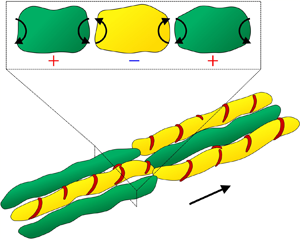Article contents
Low- and mid-frequency wall-pressure sources in a turbulent boundary layer
Published online by Cambridge University Press: 07 May 2021
Abstract

Simultaneous wall-pressure and high-speed particle image velocimetry measurements were used to identify the coherent structures that generate low- and mid-frequency wall-pressure fluctuations in a turbulent boundary layer at a friction Reynolds number of  $Re_\tau =2600$. The coherence function between wall pressure and velocity at a range of wall-normal locations revealed two distinct frequency bands of high coherence that span the low- and mid-frequency regions of the wall-pressure spectrum. Pressure was filtered to isolate the frequencies associated with each region of high coherence, and space–time pressure-velocity correlations were computed using the filtered signals to expose the motions responsible for the observed pressure-velocity coupling. The resulting correlation patterns were attributed to very-large-scale motions (VLSMs) and hairpin packets, revealing that these two types of coherent motions are the dominant sources of wall-pressure fluctuations at the low and mid frequencies. Although the VLSMs and hairpin packets are closely related, the mechanisms by which these motions affect wall pressure were found to be different. The VLSMs were found to cause positive and negative wall-pressure fluctuations via splatting and lifting of fluid at the wall, respectively. In contrast, hairpin packets affected wall pressure because of their low-pressure vortex cores and regions of high-pressure stagnation. The frequency at which the wall-pressure source changes from the VLSMs to the hairpin packets coincided with the peak of the wall-pressure spectrum, suggesting that the peak may be a result of the transition between pressure sources that occurs at the same point in the frequency domain.
$Re_\tau =2600$. The coherence function between wall pressure and velocity at a range of wall-normal locations revealed two distinct frequency bands of high coherence that span the low- and mid-frequency regions of the wall-pressure spectrum. Pressure was filtered to isolate the frequencies associated with each region of high coherence, and space–time pressure-velocity correlations were computed using the filtered signals to expose the motions responsible for the observed pressure-velocity coupling. The resulting correlation patterns were attributed to very-large-scale motions (VLSMs) and hairpin packets, revealing that these two types of coherent motions are the dominant sources of wall-pressure fluctuations at the low and mid frequencies. Although the VLSMs and hairpin packets are closely related, the mechanisms by which these motions affect wall pressure were found to be different. The VLSMs were found to cause positive and negative wall-pressure fluctuations via splatting and lifting of fluid at the wall, respectively. In contrast, hairpin packets affected wall pressure because of their low-pressure vortex cores and regions of high-pressure stagnation. The frequency at which the wall-pressure source changes from the VLSMs to the hairpin packets coincided with the peak of the wall-pressure spectrum, suggesting that the peak may be a result of the transition between pressure sources that occurs at the same point in the frequency domain.
Information
- Type
- JFM Papers
- Information
- Copyright
- © The Author(s), 2021. Published by Cambridge University Press
References
REFERENCES
- 14
- Cited by


